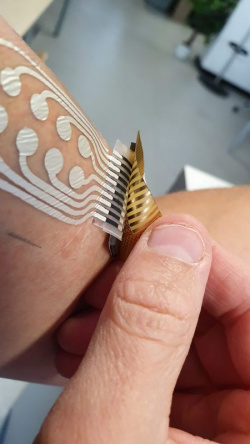Difference between revisions of "Flexible Electronic Systems and Embedded Epidermal Devices"
From iis-projects
(→Flexible Electronic Systems and Embedded Epidermal Devices) |
(→Flexible Electronic Systems and Embedded Epidermal Devices) |
||
| Line 9: | Line 9: | ||
However, the '''development''' of such systems is associated with a '''number of challenges'''. These are not only the material properties per se (e.g. flexibility, stretchability or biocompatibility), but also their advanced and specialized manufacturing techniques. In addition, there are reliability problems due to bending and mechanical stress on the entire stack, as well as interface challenges at all levels of integration. | However, the '''development''' of such systems is associated with a '''number of challenges'''. These are not only the material properties per se (e.g. flexibility, stretchability or biocompatibility), but also their advanced and specialized manufacturing techniques. In addition, there are reliability problems due to bending and mechanical stress on the entire stack, as well as interface challenges at all levels of integration. | ||
| − | |||
| − | |||
==Our Activities== | ==Our Activities== | ||
Revision as of 23:47, 5 February 2023
Contents
Flexible Electronic Systems and Embedded Epidermal Devices
Flexible Electronic Systems utilize polymers and other flexible or strechable materials to form wearable and conformable devices. These system are often composed of various flexible, bendable but also small ridgid components, such as electrodes, transducers, energy storage units, transistors and complete IC's.
These designs allow for comfortable wear, as they can be positioned closely to or even attached to the human body (as epidermal devices). In addition, and through the integration of digital electronic components, these devices can process a wide range of complex functions, such as continuous monitoring and modulation of physiological signals or communication with other devices.
However, the development of such systems is associated with a number of challenges. These are not only the material properties per se (e.g. flexibility, stretchability or biocompatibility), but also their advanced and specialized manufacturing techniques. In addition, there are reliability problems due to bending and mechanical stress on the entire stack, as well as interface challenges at all levels of integration.
Our Activities
Contact
Christoph Leitner
|
Projects
All projects are annotated with one or more possible project types (M/S/B/G) and a number of students (1 to 3).
- M: Master's thesis: 26 weeks full-time (6 months) for one student only
- S: Semester project: 14 weeks half-time (1 semester lecture period) or 7 weeks full-time for 1-3 students
- B: Bachelor's thesis: 14 weeks half-time (1 semester lecture period) for one student only
- G: Group project: 14 weeks part-time (1 semester lecture period) for 2-3 students
Usually, these are merely suggestions from our side; proposals can often be reformulated to fit students' needs.
Available Projects
- Adaptively Controlled Polarization And Hysteresis Curve Tracing For Polymer Piezoelectrics (1 S/B)
- Development Of A Test Bed For Ultrasonic Transducer Characterization (1 S/B)
- Towards Flexible and Printable Wearables

